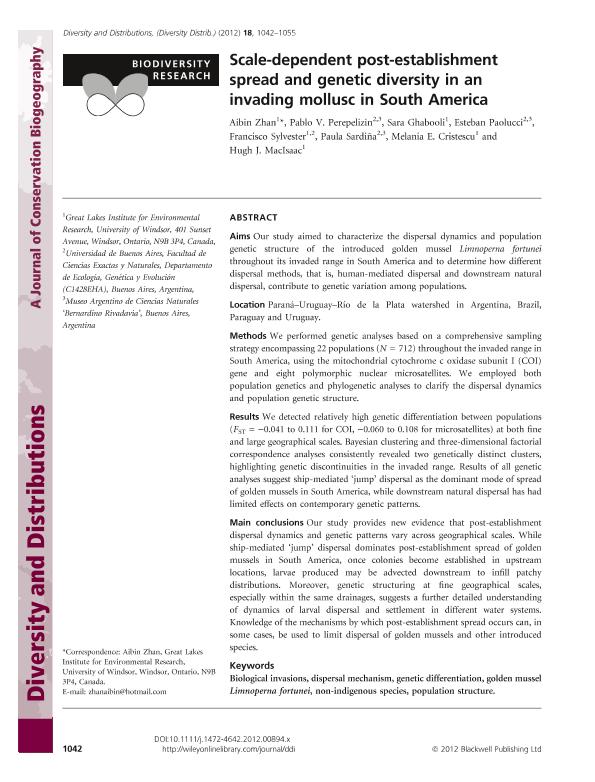Artículo
Scale-dependent post-establishment spread and genetic diversity in an invading mollusc in South America
Zhan, Aibin; Perepelizin, Pablo Victor ; Ghabooli, Sara; Paolucci, Esteban Marcelo
; Ghabooli, Sara; Paolucci, Esteban Marcelo ; Sylvester, Francisco
; Sylvester, Francisco ; Sardiña, Paula
; Sardiña, Paula ; Cristescu, Melania E.; MacIsaac, Hugh J.
; Cristescu, Melania E.; MacIsaac, Hugh J.
 ; Ghabooli, Sara; Paolucci, Esteban Marcelo
; Ghabooli, Sara; Paolucci, Esteban Marcelo ; Sylvester, Francisco
; Sylvester, Francisco ; Sardiña, Paula
; Sardiña, Paula ; Cristescu, Melania E.; MacIsaac, Hugh J.
; Cristescu, Melania E.; MacIsaac, Hugh J.
Fecha de publicación:
10/2012
Editorial:
Wiley
Revista:
Diversity And Distributions
ISSN:
1366-9516
Idioma:
Inglés
Tipo de recurso:
Artículo publicado
Clasificación temática:
Resumen
Aims: Our study aimed to characterize the dispersal dynamics and population genetic structure of the introduced golden mussel Limnoperna fortunei throughout its invaded range in South America and to determine how different dispersal methods, that is, human-mediated dispersal and downstream natural dispersal, contribute to genetic variation among populations. Location: Paraná–Uruguay–Rı´o de la Plata watershed in Argentina, Brazil, Paraguay and Uruguay. Methods: We performed genetic analyses based on a comprehensive sampling strategy encompassing 22 populations (N = 712) throughout the invaded range in South America, using the mitochondrial cytochrome c oxidase subunit I (COI) gene and eight polymorphic nuclear microsatellites. We employed both population genetics and phylogenetic analyses to clarify the dispersal dynamics and population genetic structure. Results: We detected relatively high genetic differentiation between populations (FST = )0.041 to 0.111 for COI, )0.060 to 0.108 for microsatellites) at both fine and large geographical scales. Bayesian clustering and three-dimensional factorial correspondence analyses consistently revealed two genetically distinct clusters, highlighting genetic discontinuities in the invaded range. Results of all genetic analyses suggest ship-mediated ‘jump’ dispersal as the dominant mode of spread of golden mussels in South America, while downstream natural dispersal has had limited effects on contemporary genetic patterns. Main conclusions: Our study provides new evidence that post-establishment dispersal dynamics and genetic patterns vary across geographical scales. While ship-mediated ‘jump’ dispersal dominates post-establishment spread of golden mussels in South America, once colonies become established in upstream locations, larvae produced may be advected downstream to infill patchy distributions. Moreover, genetic structuring at fine geographical scales, especially within the same drainages, suggests a further detailed understanding of dynamics of larval dispersal and settlement in different water systems. Knowledge of the mechanisms by which post-establishment spread occurs can, in some cases, be used to limit dispersal of golden mussels and other introduced species.
Archivos asociados
Licencia
Identificadores
Colecciones
Articulos(IEGEBA)
Articulos de INSTITUTO DE ECOLOGIA, GENETICA Y EVOLUCION DE BS. AS
Articulos de INSTITUTO DE ECOLOGIA, GENETICA Y EVOLUCION DE BS. AS
Articulos(MACNBR)
Articulos de MUSEO ARG.DE CS.NAT "BERNARDINO RIVADAVIA"
Articulos de MUSEO ARG.DE CS.NAT "BERNARDINO RIVADAVIA"
Citación
Zhan, Aibin; Perepelizin, Pablo Victor; Ghabooli, Sara; Paolucci, Esteban Marcelo; Sylvester, Francisco; et al.; Scale-dependent post-establishment spread and genetic diversity in an invading mollusc in South America; Wiley; Diversity And Distributions; 18; 10; 10-2012; 1042-1055
Compartir
Altmétricas



